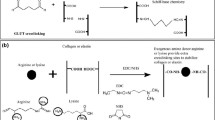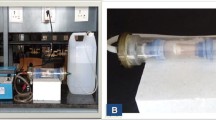Summary
The cell adhesive properties of decellularized valve scaffolds were promoted by immobilization of valve scaffold with arginine-glycine-aspartic acid (RGD)-containing peptides. Porcine aortic valves were decellularized with trypsin/EDTA, and detergent Triton X-100. With the help of a coupling reagent Sulfo-LC-SPDP, the valve scaffolds were immobilized with glycine-arginine-glycine-aspartic acid-serine-proline-cysteine (GRGDSPC) peptide. X-ray photoelectron spectroscopy (XPS) was used for surface structure analysis. Myofibroblasts harvested from rats were seeded onto the valve scaffolds. Cell count by using microscopy and modified MTT assay were performed to assess cell adhesion. Based on the spectra of XPS, the conjugation of GRGDSPC peptide with decellularized valve scaffolds was confirmed. Both cell count and MTT assay showed that myofibroblasts were much easier to adhere to the modified valve scaffolds, which was also confirmed histologically. Our findings suggest that it is feasible to immobilize RGD-containing peptides onto decellularized valve scaffolds. And the technique can effectively promote cell adhesion, which is beneficial for in vitro tissue engineering of heart valves.
Similar content being viewed by others
References
Hersel U, Dahmen C, Kessler H. RGD modified polymers: biomaterials for stimulated cell adhesion and beyond. Biomaterials, 2003,24(24):4385–4415
Jeschke B, Meyer J, Jonczyk A, et al. RGD peptides for tissue engineering of articular cartilage. Biomaterials, 2002,23(16):3455–3463
Boontheekul T, Mooney DJ. Protein-based signaling systems in tissue engineering. Curr Opini Biotechnol, 2003,14(5):559–565
Lutolf MP, Weber FE, Schmoekel HG, et al. Repair of bone defects using synthetic mimetics of collagenous extracellular matrices. Nat Biotechnol, 2003,21(5):513–518
Myles JL, Burgess BT, Dickinson RB. Modification of the adhesive properties of collagen by covalent grafting with RGD peptides. J Biomater Sci Polymer Edn, 2000,11(1):69–86
Verrier S, Pallu S, Bareille R, et al. Function of linear and cyclic RGD containing peptides in osteoprogenitor cell adhesion process. Biomaterials, 2002,23(2):585–596
Flanagan TC, Pandit A. Living artificial heart valve alternatives. Euro Cell Mater, 2003,6:28–45
Dong NG, Shi JW, Hu P, et al. Current progress on scaffolds of tissue engineering heart valves. Front Med China, 2008,2(8):229–234
Cebotari S, Mertsching H, Kallenbach K, et al. Construction of autologous human heart valves based on an acellular allograft matrix. Circulation, 2002,106(12 Suppl 1):63–68
Erdbrugger W, Konertz W, Posner S, et al. Decellularized xenogenic heart valves reveal remodeling and growth potential in vivo. Tissue Eng, 2006,12(8): 2059–2068.
Schenke-Layland K, Vasilevski O, Opitz F, et al. Impact of decellularization of xenogeneic tissue on extracellular matrix integrity for tissue engineering of heart valves. J Struct Biol, 2003,143(3):201–208
Dong NG, Ye XF, Shi JW, et al. Comparison on decellularizing approaches of biological scaffold with porcine aortic valve for tissue engineering heart valve. Chin J Exp Surg (Chinese), 2005,22:377
Shi JW, Dong NG, Sun ZQ. Impact of immobilized RGD peptides on cell attachment of collagen scaffold. Acta Med Univ Sci Technol Huazhong (Chinese), 2007,36(2):214–216
Shi JW, Dong NG. Application of RGD peptides in the field of tissue engineering. Chin J Exp Surg (Chinese), 2005,22:1150–1152
Quirk RA, Chan WC, Daries MC, et al. Poly (L-lysine)-GRGDS as a biomimetic surface modifier for poly(lactic acid). Biomaterials, 2001,22(8):856–872
Schaffner P, Dard MM. Structure and function of RGD peptides involved in bone biology. Cell Mol Life Sci, 2003,60(1):119–132
Dreger SA, Thomas P, Sachlos E, et al. Potential for synthesis and degradation of extracellular matrix proteins by valve interstitial cells seeded onto collagen scaffolds. Tissue Eng, 2006,12(9):2533–2540
Mendelson K, Schoen FJ. Heart valve tissue engineering: concepts, approaches, progress, and challenges. Ann Biomed Eng, 2006,34(12):1799–1819
Author information
Authors and Affiliations
Additional information
This project was supported by grants from the National Natural Sciences Foundation of China (No. 30571839 and 30600608).
Rights and permissions
About this article
Cite this article
Shi, J., Dong, N. & Sun, Z. Immobilization of decellularized valve scaffolds with Arg-Gly-Asp-containing peptide to promote myofibroblast adhesion. J. Huazhong Univ. Sci. Technol. [Med. Sci.] 29, 503–507 (2009). https://doi.org/10.1007/s11596-009-0422-8
Received:
Published:
Issue Date:
DOI: https://doi.org/10.1007/s11596-009-0422-8




